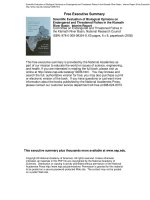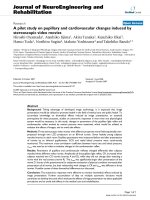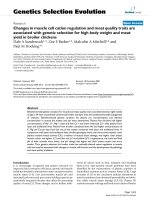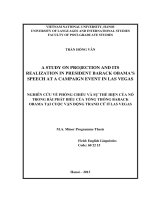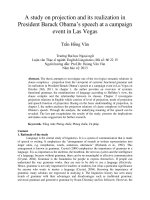Study on pathomorphological and biochemical changes in experimentally induced necrotic enteritis in broiler chicken
Bạn đang xem bản rút gọn của tài liệu. Xem và tải ngay bản đầy đủ của tài liệu tại đây (599.12 KB, 16 trang )
Int.J.Curr.Microbiol.App.Sci (2019) 8(1): 2795-2810
International Journal of Current Microbiology and Applied Sciences
ISSN: 2319-7706 Volume 8 Number 01 (2019)
Journal homepage:
Original Research Article
/>
Study on Pathomorphological and Biochemical changes in Experimentally
Induced Necrotic Enteritis in Broiler Chicken
K.C. Suryakanth1, M.L. Sathyanarayan1, K.C. Mallinath2, H.D. Narayanaswamy1*,
Shravan Kumar1, G. Sugunarao1, Upendra3 and N.B. Shridhar3
1
Department of Veterinary Pathology, Veterinary College, KVAFSU, Bengaluru
2
IAH &VB, Bengaluru, India
3
Veterinary College, Bengaluru, India
*Corresponding author
ABSTRACT
Keywords
Necrotic enteritis,
Clostridium,
Eimeria, Broiler
chicken and
Livacox
Article Info
Accepted:
17 December 2018
Available Online:
10 January 2019
The present work was carried out to study the patho-morphological and
biochemical changes in experimentally induced Necrotic enteritis in broiler
chicken. Two experimental groups T1 & T2 each comprising of 40 day old female
broiler chicks, were fed with normal feed on day 1 to 16. On day17th, 18th, 19th and
20th, they were orally administered with Clostridium perfringens at the dose rate of
4X108 CFU per bird thrice a day along with 10 times the dose of Livacox vaccine
on day18th then from day 21 to 42 normal feed was fed to both the groups. There
was significant difference in the parameters such as body weight, feed
consumption, FCR, serum AST, ALT, total proteins. Impression smears of
intestine showed significant gross and histopathological changes in the clostridium
challenged birds compared to normal control.
Introduction
Necrotic Enteritis is a disease of major
economic importance affecting the poultry
industry worldwide. Globally, the cost of the
disease estimated to be over US$2 billion per
year due to production losses and treatment
expenses. The causative agents of Necrotic
Enteritis are Clostridium perfringens toxin
Type A strains which produce the Net B toxin
(Keyburn et al., 2010).The disease is common
in 2 to 6 week old broiler chicken occurring
mainly in three different forms i.e., clinical,
subclinical and mild form. The onset of
Necrotic enteritis is, however, a multifactorial
event in which subclinical coccidiosis is
believed to be one of the major predisposing
factors along with high protein and high
wheat composition in the diet. Hence present
study was undertaken to know the changes in
pathomorphological
and
biochemical
parameters in experimentally induced necrotic
enteritis in broiler chicken.
Materials and Methods
The study was carried out in broiler chicken
at Department of Veterinary Pathology,
2795
Int.J.Curr.Microbiol.App.Sci (2019) 8(1): 2795-2810
Veterinary College, KVAFSU, Hebbal,
Bangalore–560024, for a period of 42 days
with prior approval of the Institutional
Animal Ethical Committee of Veterinary
College Bangalore.
Group 2 (T2) - Birds
challenged
with
Clostridium
perfringens
(Clostridia
challenged)
Experimental
Enteritis
induction
of
Necrotic
Experimental chicks
An in vivo study was carried out using a day
old female broiler chicks distributed in two
groups, each comprising 40 chicks. The
groups were reared in cages with a density of
ten birds/6sq. ft in two-tier system and
standard management practices were followed
to rear them.
The birds were fed with starter, grower and
finisher feed as per age of the bird during the
period of experiment. Prophylactically
vaccination and medication was administered
as per standard protocol.
Three periods during the study were well
separated ie., pre-challenge, challenge and
post challenge.
Pre challenge: Day1 to 16 where in, a normal
feed was fed to the birds in T1 and T2.
Challenge: The birds in group T2 was
challenged with Clostridium perfringens on
Day 17, 18, 19 and 20 and given coccivac
vaccine with ten folds dilution on Day 18.
Post challenge: Comprised a period from
Day 21 to 42 where a normal feed was fed to
both the groups.
Strain of Bacteria and Coccidia vaccine
The Clostridium perfringens Type A (ATCC
No. 13124) organisms were procured from
National Chemical Laboratory, National
Collection of Industrial Microorganisms
(NCIM), Pune, Maharashtra. The Livacox, a
live attenuated coccidiosis vaccine containing
30,000 to 50,000 of each of attenuated lines
of Eimeria acervulina, Eimeria maxima and
Eimeria tenella and 10,000 oocysts of
Eimeria necatrix in 1% water solution of
Chloramine B procured from M/S Elanco,
Bangalore.
Experimental design
The chicks were divided into two groups with
40 chicks in each group weighing equally on
Day 1.
Group 1 (T1) - Birds fed with normal feed and
non challenged (Normal control) and used for
studying base line values of the parameters.
Challenge: The birds were challenged
according to the method described by
Lankriet et al, (2010). Broilers were fed a
conc (45-55%) diet, with soybean meal as
protein source. From Day 17 onwards, the
same diet was used with the exception that
fishmeal (30%) replaced soy bean as the
protein source. Prior to challenge, the birds of
the group T2 were starved overnight to induce
stress. They were administered orally using a
sterile plastic syringe (Three times a day) with
approximately 4x108 colony-forming units of
Clostridium perfringens bacteria on Days 17,
18, 19 and 20. On Day 18, all birds were
orally administered with a ten-fold dose of
Coccivac.
Clinical observations
Birds of both the groups were observed for
feed and water intake, general behaviour,
alertness, diarrhoea and any other clinical
symptoms.
2796
Int.J.Curr.Microbiol.App.Sci (2019) 8(1): 2795-2810
Collection of serum samples
About 5 ml of blood was collected from each
bird of both the groups separately during
sequential sacrifices i.e., on 22nd, 24th, 26th
and 42nd days of the experiment. The serum
was separated and stored at -200 C until
subjected for ALT, AST and Total protein
estimation.
Sequential pathology
Ten birds from the T2-Group were euthanized
sequentially to study the challenge effect.
Gross changes if any were recorded during
post-mortem examination. Representative
tissue samples from different segments of
intestine (Duodenum, Jejunum, Ileum and
Caecum) and liver 3-5 mm thickness were
collected in ten per cent neutral buffered
formalin (NBF) for histopathology (Luna,
1968).
Parameters analyzed
Parameters like daily feed consumption,
weekly body weight and biochemical
parameters like AST, ALT & TP were
analyzed as per standard protocol followed by
Tietz, (1976)
Statistical analysis
Statistical analysis was performed with
statistical software SPSS Statistics 17.0
software (SPSS Inc., Chicago, Illinois, USA).
Mean values and standard error for the total
serum protein, AST and ALT values were
analysed using one way analysis of variance
(ANOVA) and were expressed as mean (±
SE).
Results and Discussion
Necrotic Enteritis is primarily a disease of
young chickens caused by infection with a
toxin produced by Clostridium perfringens
Type A, and to lesser extent by Type C
organism (Songer and Meer, 1997).
Experimental induction
In the current study, Necrotic enteritis was
induced in Group T2 (Clostridia challenged)
by oral administration of Clostridium
perfringens Type A bacteria on Day 17, 18,
19, 20 at the dose rate of 4 x 108 cfu per bird
per inoculation (Three times a day) as
described by Olkowski et al., (2006) and
Pedersen et al., (2008).
On Day 18, all birds were orally inoculated
with a ten-fold dose of Coccivac in order to
create predisposing condition which results in
intestinal damage leading to release of plasma
proteins into the lumen of the intestinal tract.
This provides 11 amino acids which acts as
necessary growth substrate for extensive
proliferation of these bacteria and thus
leading to necrosis of intestinal epithelium
(Baba et al., 1992; Kaldhusdal et.al., 1999).
Clinical signs
In the present study, the group challenged
with Clostridium perfringens showed
apparent clinical signs like of depression,
reluctance to move, loss of appetite, ruffled
feathers, drooping of wings and head,
diarrhoea, dehydration, reduced growth rate
and an inclination to huddle together under
the heat source and no signs are observed in
normal control group (Fig. 1).
Performance
Feed consumption (g)
The mean (± SE) feed consumption of T1
Group (Normal control) showed gradual
increase in feed intake from 1st to 6th week.
The mean (± SE) feed consumption of T2
2797
Int.J.Curr.Microbiol.App.Sci (2019) 8(1): 2795-2810
Group (Clostridia challenged) birds were
observed to be normal during 1st and 2nd
week; There was progressive decrease in the
rate of feed intake from 3rd to 6th week. The
mean feed consumption from 3rd to 6th week
was significantly lower (P≤0.05) when
compared with normal control bird (Table 1).
(P≤0.05) compared to normal control (T1)
birds (Table 2). The reduction in the total
protein levels could be due to degeneration of
endoplasmic reticulum in hepatocytes and
covalent binding of Clostridial metabolites to
template RNA. This process causes inhibition
of transcription steps in protein synthesis as
reported by Shane et al., (1985).
Feed Conversion Ratio (FCR)
Gross pathology: (Table 3)
The mean (± SE) FCR values of T2 group
(Clostridia challenged) showed a normal FCR
during 1st to 3rd week and an increase in FCR
values from 4th to 6th week respectively,
which were significantly higher (P≤0.05)
compared to normal control birds (Table 1)
Serum biochemistry
Serum AST and ALT
Birds of the Group T2 (Clostridia challenged)
showed a significant increase (P≤0.05) in the
mean (±SE) serum aspartate amino
transferase (AST) and Alanine amino
transferase (ALT) values when compared
with normal group, which could be attributed
to hepatic degeneration, necrosis and
subsequent leakage of enzymes. AST and
ALT are leakage enzymes present in the
cytosol and organelles of hepatocytes (Table
2). Usually there is high concentration
gradient between the hepatocytes and the
sinusoidal space for enzymes. Cell damage
increases permeability causing cytosolic isoenzymes to spill into the sinusoids and from
there to peripheral blood (Shane et al.,
1985).The birds of normal control (T1) group
also maintained a constant mean serum AST
and ALT levels throughout the experiment.
Serum total protein (TP)
In the present study, the mean (±SE) Serum
total protein (TP) values of Clostridia
challenged (T2) birds were significantly lower
Small intestine
In the present investigation, birds in the T1
(Normal control) group did not reveal any
morphological derangement in any of the
segments of the intestine throughout the
experimental study. While birds in the T2
Group which were infected with Clostridium
perfringens revealed distended thin walled
duodenum. Serosal surface appeared dull
pink, with engorged serosal vessels. The
mesenteric vessels were engorged with blood.
Mucosal surface of the duodenum showed
patches of haemorrhages and focal areas of
necrosis, with brown colour diphtheritic
membrane (Kaldhusdal and Hofshagen,
1992). Jejunum and ileum revealed focal
areas of necrosis, patches of multifocal
haemorrhages and thin walled, containing
blood tinged flocculent fluid. Mucosal surface
covered with yellow to green sometimes grey
to brown colour diphtheritic membrane.
Serosal surface appeared dull pink, with
engorged vessels (Fig. 2-6).
The findings in the experiment were in
accordance with findings of Long and
Barnum, (1974), Broussard et al., (1986).
They opined that various gross lesions in the
duodenum, jejunum and ileum could be due
to production of α toxin by Clostridium
perfringens bacteria which stimulates the
arachidonic acid cascade to induce the
production of inflammatory mediators like
leucotrienes, prostacyclins, platelet activating
2798
Int.J.Curr.Microbiol.App.Sci (2019) 8(1): 2795-2810
factor and thromboxanes which contribute for
contraction of blood vessels and aggregation
of platelets leading to above changes.
Large intestine
In the present study, normal control birds did
not show any gross lesions in the large
intestine throughout the experimental study.
Birds
challenged
with
Clostridium
perfringens (T2) showed various lesions in
the Caecum viz., irregular, focal or locally
extensive depressions on the mucosal surface,
multifocal or locally extensive haemorrhages
with focal areas of necrosis in the ceacal
tonsils. Mucosa was lined by yellow or
greenish, loosely adherent pseudo-membrane.
All the above lesions could be attributed to
production of α toxin by the bacterium and
similar observations were made by
Gholamiandehkordi et al., (2007).
Liver
Birds in the T1 (Normal control) group did
not reveal any lesions in the liver and
appeared normal. Clostridia challenged (T2)
birds showed focal areas of necrosis and
haemorrhages with discolouration of the
extra-hepatic bile tree and occasional focal
subcapsular nodules. These lesions observed
in the liver of Clostridia challenged (T2) birds
suggested that α toxin produced in the
intestine by the Clostridium perfringens
through entero hepatic circulation reached
liver and caused damage to the liver tissue
(Lovland and Kaldhusdal, 1998).
Histopathology
Small intestine
Microscopically, birds belonging to Groups
T1 (Normal control) did not show any
pathological changes in the small intestine
(Fig.7-9). Clostridia challenged (T2) birds’
revealed degeneration and desquamation of
surface epithelium which could be attributed
to direct effect of alpha toxin of Clostridium
perfringens on the cellular membranes which
results in segmental loss of mucosal epithelial
cells. Increased goblet cell activity could be
due to intestinal irritation caused by
Clostridial organisms and its toxins on the
surface epithelial cells. Distension of lacteals,
congestion, focal haemorrhages in the tip and
core of villi attributed to inflammatory
changes initiated by Clostridium perfringens
which stimulates the arachidonic acid cascade
to induce the production of inflammatory
mediators like leucotrienes, prostacyclins,
platelet activating factor and thromboxanes,
which leads to contraction of blood vessels
and aggregation of platelets (Titball et al.,
1993). Marked to diffuse coagulative necrosis
of the mucosal layer of the small intestine,
severe necrosis involving luminal third to half
of mucosa, delimited intestinal epithelium
with few masses of tissue fragments, necrotic
cells and numerous bacterial colonies
suspended in mucus matrix with formation of
pseudo-membrane were the other features
observed in the present study. This could be
related to production of α toxin by
Clostridium perfringens which causes
disorganization of mucus membrane leading
to cell death (Songer and Meer, 1997) (Fig.
10-15).
Large intestine
Birds in the normal control group showed
normal architecture of the large intestine
throughout the experimental study (Fig. 16).
Group T2 (Clostridia challenged) birds
revealed denudation and necrosis of the
epithelial layer of the submucosa, moderate to
severe degree of goblet cell activity, presence
of clusters of organisms freely as well as
adhered to the cell surface and patches of
multifocal haemorrhagic areas covering the
lamina-propria and lamina-muscularis. There
2799
Int.J.Curr.Microbiol.App.Sci (2019) 8(1): 2795-2810
was also infiltration of inflammatory cells in
the lamina propria of the sub mucosa. All
these findings suggested effect of clostridium
infection in the challenged group as observed
by Smyth and Martin, (2010) (Fig.17- 19).
Table.1 The mean (±SE) body weight (gm), Feed consumption and FCR values of Normal
control, Clostridia challenged, Groups at weekly intervals of time
Parameters
Body weight
Feed
Consumption
FCR
Treatment
Groups
T1 (Normal
control)
T2 (Clostridia
challenged)
T1 (Normal
control)
T2 (Clostridia
challenged)
T1 (Normal
control)
T2 (Clostridia
challenged)
1st Week
91.68±
4.17a
90.13±
1.33a
171.98±
9.1a
171.95±
10.50a
1.89±
0.13a
1.91±
0.13a
2nd Week
310.58±
20.56a
302.95±
6.63a
476.92±
26.80a
488.70±
19.85a
1.56±
0.15a
1.6± 0.05a
Different time intervals
3rd Week 4th Week
648.83± 1197.5±
20.19b
14.03c
553.25± 890.00±
13.92a
13.52a
912.45± 2184.70±
23.86b
101.68b
810.00± 1889.00±
5.15a
44.44a
1.41±
1.82±
0.08a
0.07a
1.47±
2.12±
0.04a
0.07b
5th Week
1757.8±
24.0c
1320.13±
58.4a
3032.69±
146.27b
2734.50±
77.57a
1.72±
0.07a
2.02±
0.14b
6th Week
2145.3±
58.28b
1718.45±
41.3a
3831.17±
203.28b
3473.25±
137.06a
1.78±
0.06a
2.02±
0.08b
All the values are expressed as mean (± SE), The values between the Groups for each week with super script a, b, and c are
statistically significant at P≤0.05
Table.2 The mean (±SE) AST, ALT (IU/L) and Total Protein (g/dL) values of Normal control,
Clostridia challenged, Groups at different time intervals
Parameters
AST
ALT
TP
Treatment
Groups
T1 (Normal
Control)
T2 (Clostridia
challenged)
T1 (Normal
Control)
T2 (Clostridia
challenged)
T1 (Normal
control)
T2 (Clostridia
challenged)
st
1 Sacrifice
(Day 22)
174.91 ±
0.14a
197.30 ±
2.02b
24.97 ±
1.61a
51.42 ±
9.17b
56.42 ±
0.15b
32.19 ±
1.60a
Sequential sacrifice
2nd
3rd
Sacrifice
Sacrifice
(Day 24)
(Day 26)
176.10 ±
173.69 ±
a
0.58
1.89a
204.30 ±
202.86±
2.09b
3.89b
27.86 ±
29.55 ±
0.90a
1.11a
53.50 ±
48.38 ±
11.74b
4.09b
55.24 ±
55.65 ±
b
0.37
0.58b
27.84 ±
29.99 ±
a
2.23
1.63a
4th Sacrifice
(Day 42)
172.62 ±
3.40a
190.97 ±
4.19b
29.78 ±
2.92a
45.46 ±
6.26b
56.18 ±
0.19b
24.07 ±
1.71a
All the values are expressed as mean (± SE), The values between the Groups for each sacrifice with super script a
and b are statistically significant at P≤0.05
2800
Int.J.Curr.Microbiol.App.Sci (2019) 8(1): 2795-2810
Table.3 Gross lesions observed in birds infected with Clostridium perfringens (T2) at different
time intervals (Sequential sacrifice)
Different
segments of
intestine
examined
Duodenum
Jejunum
Ileum
Caecum
Time intervals in days
22nd 24rth 26th 42nd Total
%
10
10
10
10
40
100
No of birds
examined
Type of lesions
Congestion
8
10
8
9
35
87.50
Hemorrhage
8
9
8
7
32
80.00
Necrosis
9
8
8
6
31
77.50
Pseudomembrane formation
1
2
3
1
7
17.50
Congestion
9
10
10
8
37
92.50
Hemorrhage
7
8
9
8
32
80.00
Necrosis
9
10
10
9
38
95.00
Pseudomembrane formation
1
2
4
1
8
20.00
Congestion
7
8
8
8
31
77.50
Hemorrhage
7
7
8
7
29
72.50
Necrosis
9
10
9
8
36
90.00
Pseudomembrane formation
0
2
2
1
4
10.00
Congestion
8
9
9
8
34
85.00
Hemorrhage
8
7
7
6
28
70.00
Necrosis
9
7
8
8
32
80.00
Pseudomembrane formation
1
4
3
1
9
22.50
Fig.1 Photograph to show Clostridia challenged (T2) bird compared with the Normal control
(T1) bird on 42nd day of experiment. Note the variation in body size, condition and feather
pattern of birds
2801
Int.J.Curr.Microbiol.App.Sci (2019) 8(1): 2795-2810
Fig.2 Photograph to show serosal surface of intestine from Clostridia challenged (T2) bird. Note
the haemorrhagic patches, focal areas of necrosis with engorged serosal vessels on 42nd day of
experiment
Fig.3 Photograph of mucosal surface of ileum from Clostridia challenged (T2) bird to show
patches of haemorrhages with green to yellow diphtheritic membrane
Fig.4 Photograph of Duodenum from Clostridia challenged (T2) bird to show extensive
haemorrhages spreading almost whole length of the duodenum on 24th day of the experiment
2802
Int.J.Curr.Microbiol.App.Sci (2019) 8(1): 2795-2810
Fig.6 Photograph of Jejunum from Clostridium infected bird (T2) showing sloughing off
mucosal epithelium and pseudomembrane formation, on 26th day of the experiment
Fig.7 Photomicrograph of jejunum from Normal control (T1) bird to show intact villus
architecture on 24th day of the study. H&E X 100
Fig.8 Photomicrograph of duodenum from Normal control (T1) bird to show normal intact villus
architecture on 24th day of the experiment. H&E X 200
2803
Int.J.Curr.Microbiol.App.Sci (2019) 8(1): 2795-2810
Fig.9 Section of ileum from Normal control (T1) bird to show normal villus architecture on day
24th of the experiment. H&E X 200
Fig.10 Section of duodenum from Clostridia challenged (T2) bird to show denudation and
desquamation of superficial epithelial layer of tunica mucosa on day 26nd of the experiment.
H&E X 40
Fig.11 Photomicrograph of jejunum from Clostridia challenged (T2) bird to show denudation,
desquamation of superficial epithelial layer of tunica mucosa on 24th day of experiment. H&E X
40
2804
Int.J.Curr.Microbiol.App.Sci (2019) 8(1): 2795-2810
Fig.12 Photomicrograph of jejunum from Clostridia challenged (T2) bird to show denudation of
villus epithelium with areas of necrosis, mononuclear cell infiltration and haemorrhages on 26th
day of the study. H&E X 100
Fig.13 Photomicrograph of ileum from Clostridia challenged (T2) bird to show haemorrhages,
mononuclear cell infiltration, oedema at the basement membrane, necrosis and detachment of
epithelium on 24th day of the experiment. H&E X 200
Fig.14 Section of jejunum from Clostridia challenged (T2) bird to show adherence of organisms
to the epithelial cell surface of tunica mucosa on day 26th of the experiment. H&E X 1000
2805
Int.J.Curr.Microbiol.App.Sci (2019) 8(1): 2795-2810
Fig.15 Section of jejinum from Clostridia challenged (T2) bird to show Clostridial organisms
colonized on the surface epithelium. H&E X
Fig.16 Photomicrograph of Caecum from Normal control bird (T1) to show normal appearance
on 24th day of the experiment. H&E X 100
Fig.17 Photomicrograph of Caecum from Clostridia challenged (T2) bird in higher magnification
to show attachment of cluster of gram positive Clostridial organisms to cell surface on 24th day
of the experiment (H&E X 1000)
2806
Int.J.Curr.Microbiol.App.Sci (2019) 8(1): 2795-2810
Fig.18 Section of ileo-ceacal junction from Clostridia challenged (T2) bird to show denudation
and desquamation of superficial epithelial layer of the tunica submucosa on 26th day of the
study. H&E X 40
Fig.19 Photomicrograph of Caecum from Clostridia challenged (T2) bird in higher magnification
to show haemorrhages at the tip of mucosa, segmental loss of surface epithelium due to necrosis
on 24th day of the study. H&E X 40
Fig.20 Liver section from Clostridia challenged (T2) bird to show focal area of necrosis around
the central vein and infiltration of mononuclear cells with vacuolar changes in hepatocytes on
24th day of the experiment. H&E X 200
2807
Int.J.Curr.Microbiol.App.Sci (2019) 8(1): 2795-2810
Fig.21 Liver section from Clostridia challenged (T2) bird to show vacuolar changes in the
hepatocytes, congested vessels, necrosis and mononuclear cell infiltration. (H&E X 200)
Fig.22 Photomicrograph of liver from Normal control (T1) bird to show normal morphology on
day 26th of the study. (H&E X 100)
Liver
Clostridia challenged (T2) birds revealed mild
congestion, vacuolar degeneration of the
hepatocytes, mild fatty change in occasional
areas, small multifocal areas of fibrinoid
necrosis and mild periportal mononuclear cell
infiltration with cholangiolar hyperplasia
were attributed to effect caused by
Clostridium perfringens organisms. Similar
observations were noticed by Lovland and
Kaldhusdal, (2001).Birds in the normal
control group did not show any lesions on
histopathological examination (Fig. 20- 22).
It is concluded that, necrotic Enteritis could
effectively be induced by oral administration
of Clostridium perfringens at the dose rate of
4X108 colony forming units per bird thrice a
day, for four consecutive days induced in
broiler chicken. There was significant
decrease in the feed consumption and FCR of
birds induced with Necrotic Enteritis The
birds with Necrotic Enteritis showed a
significant increase in the mean serum AST
and ALT values and significant reduction in
the total protein levels.
2808
Int.J.Curr.Microbiol.App.Sci (2019) 8(1): 2795-2810
Acknowledgment
I sincerely thank Dean, Veterinary College
Bengaluru and Director IAH&VB for their
unconditional generous help provided in
terms of research facilities, technical guidance
and motivation in carrying out the present
work. I cannot forget to extend my sincere
thanks to senior and junior friends for their
moral support in carrying out present work.
References
Baba, E., Fuller, A.L., Gilbert, J.M., Thayer,
S.G. and Mc Dougald, L.R., 1992.
Effects of Eimeria brunetti infection
and dietary zinc on experimental
induction of Necrotic Enteritis in
broiler chickens. Avian. Dis., 36(1):
59-62
Broussard, C.T., Hofacre, C.L., Page, R.K.
and Fletcher, O.J., 1986. Necrotic
Enteritis in cage-reared commercial
layer pullets. Avian. Dis., 30(3): 617619
Gholamiandehkordi, A.R., Timbermont, L.,
Lanckriet, A., Broeck, D.V.M.,
Pedersen, K., Dewulf, J., Pasmans, F.,
Haesebrouck, F., Ducatelle, R. and
Van
Immerseel,
F.,
2007.
Quantification of gut lesions in a
subclinical Necrotic Enteritis model.
Avian. Pathol., 36(5): 375-382.
Kaldhusdal, M. and Hofshagen, M., 1992.
Barley inclusion and avoparcin
supplementation in broiler diets. 2.
Clinical,
pathological,
and
bacteriological findings in a mild form
of Necrotic Enteritis. Poult Sci., 71(7):
1145-1153.
Kaldhusdal, M., Hofshagen, M., Lovland, A.,
Langstrand, H. and Redhead, K.,
1999. Necrotic Enteritis challenge
models with broiler chickens raised on
litter: evaluation of preconditions,
Clostridium perfringens strains and
outcome variables. FEMS. Immunol.
Med. Mic., 24: 337-343.
Keyburn, A.L., Xu-Xia Yan, Bannam, T.L.,
Van Immerseel, F., Rood, J.I. and
Moore R.J., 2010. Association
between avian Necrotic Enteritis and
Clostridium
perfringens
strains
expressing NetB toxin. Vet. Res.,
41:21.
Lanckriet, A., Timbermont, L., De Gussem,
M., Marien, M., Vancraeynest, D.,
Haesebrouck, F., Ducatelle, R. and
Van Immerseel, F., 2010. The effect
of commonly used anticoccidials and
antibiotics in a subclinical Necrotic
Enteritis model. Avian. Pathol., 39(1):
63-68.
Long, J.R., Pettit, J.R. and Barnum, D.A.,
1974. Necrotic Enteritis in broiler
chickens. II. Pathology and proposed
pathogenesis. Can. J. Comp. Med.,
38:467-474
Lovland, A. and Kaldhusdal, M., 1998. Liver
lesions seen at slaughter as an
indicator of Necrotic Enteritis in
broiler. FEMS. Immunol. Med. Mic.,
24: 345-351
Lovland, A. and Kaldhusdal, M., 2001.
Severely
impaired
production
performance in broiler flocks with
high incidence of Clostridium
perfringens associated hepatitis. Avian
Pathol., 30: 73-81.
Luna, L.G., 1968. Routine Staining
Procedures In: Manual of Histologic
Staining Methods of the Armed Forces
Institute of Pathology. Edn. 3rd
McGraw-Hill, New York., pp 32-46
Olkowski, A.A., Wojnarowicz, C., ChirinoTrejo, M. and Drew, M.D., 2006.
Responses of broiler chickens orally
challenged
with
Clostridium
perfringens isolated from field cases
of Necrotic Enteritis. Res. Vet. Sci.,
81: 99-108.
Pedersen K., Bjerrum, L., Heuer, O.E., Lo Fo
2809
Int.J.Curr.Microbiol.App.Sci (2019) 8(1): 2795-2810
Wong, D.M.A. and Nauerby, B., 2008.
Reproducible infection model for
Clostridium perfringens in broiler
chickens. Avian Dis., 52: 34-39.
Shane, J.E., Gyimah, K.S., Harrington. and
Snider, T.G., 1985. Etiology and
pathogenesis of necrotic enteritis. Vet.
Res. Commun., 9: 269-287.
Smyth, J.A. and Martin, T.G., 2010. Disease
producing capability of NetB positive
isolates of Clostridium perfringens
recovered from normal chickens and a
cow, and NetB positive and negative
isolates from chickens with Necrotic
Enteritis. Vet. Microbiol., 146: 76-84.
Songer, J.G. and Meer, R.R., 1997. Multiplex
polymerase chain reaction assay for
genotyping Clostridium perfringens.
Am. J. Vet. Res., 58(7): 702-705.
How to cite this article:
Suryakanth, K.C., M.L. Sathyanarayan, K.C. Mallinath, H.D. Narayanaswamy, Shravan
kumar1, G. Sugunarao, Upendra and Shridhar, N.B. 2019. Study on Pathomorphological and
Biochemical changes in Experimentally Induced Necrotic Enteritis in Broiler Chicken.
Int.J.Curr.Microbiol.App.Sci. 8(01): 2795-2810. doi: />
2810

